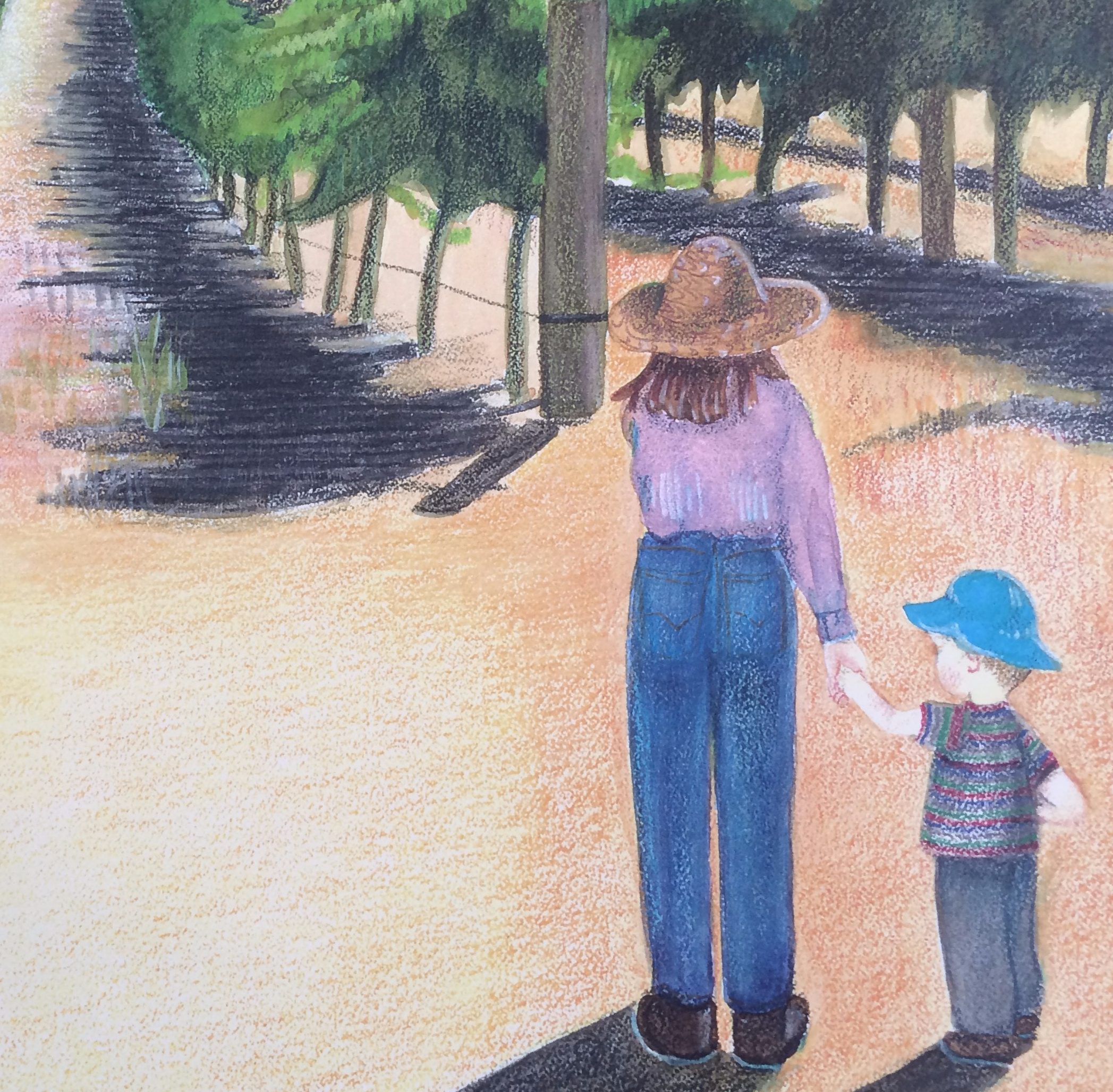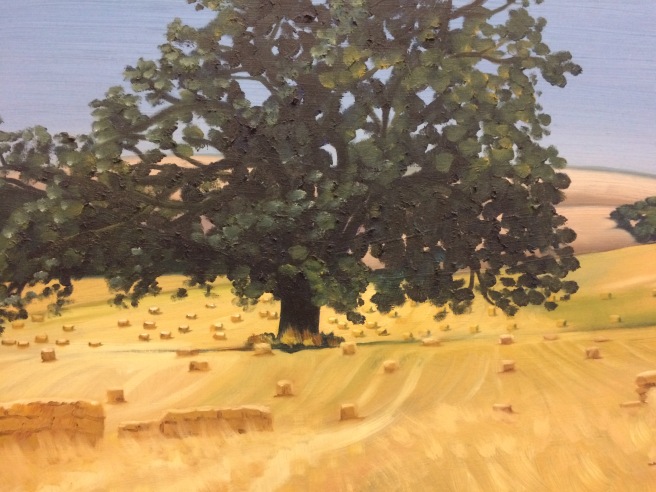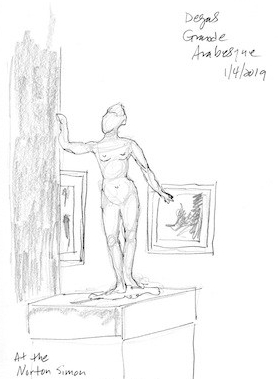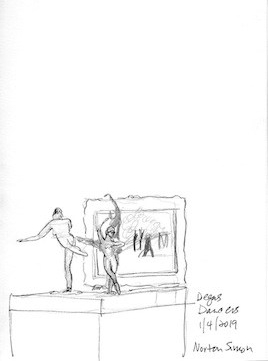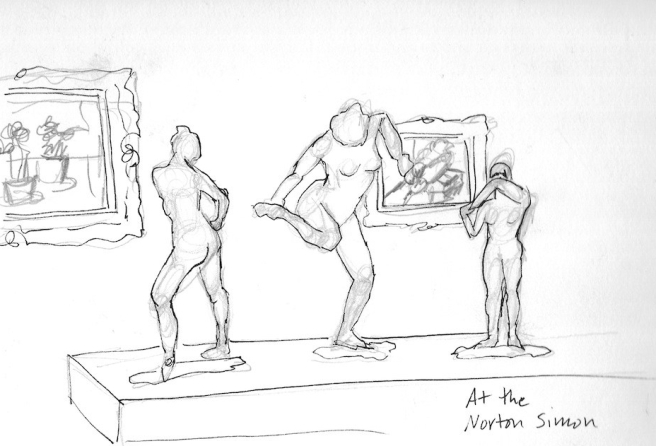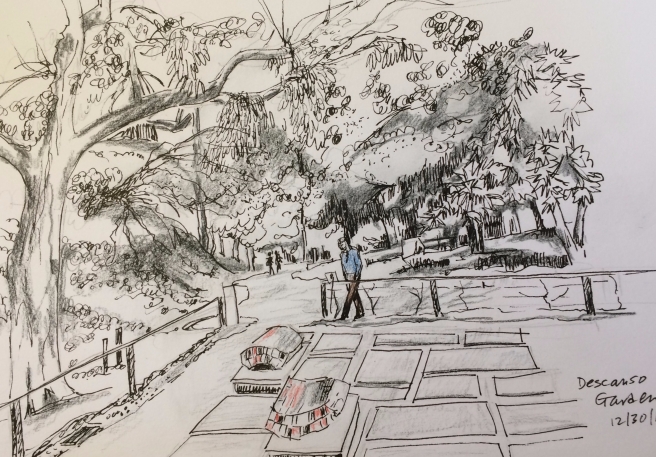
The week leading up to my painting at the Descanso Garden last Saturday was very rainy in LA. By Friday, the days of rainy weather had finally ceased and if you had been in downtown during all that constant wetness, you would have welcomed that particular rainless overcast sky day. You would no longer be looking down at the water streaming around your rain boots and down the streets, but rather looking up at the beautiful trees all around you. You also wouldn’t have had to look past and dodge an endless sea of umbrellas, but rather enjoy the greening up of the shrubbery and other plantings at eye level. It’s funny, but a sense of “green all around” can be felt in southern CA just after the rain. You really notice it. But you know it won’t last long when the winter/early spring rain ends and the daytime temperatures are in the 60s and 70s. And if you had been walking around for what seemed like weeks and weeks in the punishing rain, you may have wanted to catch the brief glimpse of the greening of Los Angeles County.
So, when the sun tried to come from behind the clouds on Friday, I decided I would go to the Descanso Garden the next day, Saturday. I knew I wanted to look for bright green new growth leaves as well as shiny sparkling leaves that had been washed clean of a layer of dull dirt. And this is what you see represented here—lots of bright dots of light reflecting off new clean growth. It was overcast again last Saturday, but that was fine with me as I could sit on a bench that was not near any shade in the rose garden. It is not a common place for me to have often considered as that particular bench is out in the open with no nearby shade cover. As the springtime temperatures go up it will get too warm to sit there. And as you can see the sky was not my cerulean blue, but a bright shade of cream. I felt like I was in heaven.
Now it may seem that the final story here is not about the bright and sparkling “new growth” on trees. You may have noticed the reference I made to slogging around in the rain in downtown LA, and you may have guessed that somehow the rain factors more into this week’s CA tale. You would be right. The story for a particular week in one California girl’s life in mid January 2019 in LA ends in a garden, but begins with some very rainy and stressful days in downtown. Here’s the rest of the story. When I initially planned this week’s post I had hoped I could be clever and write a kind short story, where there is an unexpected ending, like it was all a dream, or he bought her a comb for her hair and she bought him a pocket watch chain or the guy you thought was human was really a robot. In the opening paragraph I had planned to weave in the unhappy “contract” story of teachers in the second largest school district in the country. Through the guise of treetops, tall buildings and punishing rain you would learn of the work stoppage, or strike, that occurred for an extended week starting January 14 through the 22nd for LAUSD teachers. I realized I was probably not a clever enough writer to create a really good short story about the roughly 30,000 people that hung out at various rallies in the rain in downtown LA during that time. I’m not sure I could have pulled off a great “twist ending” for my story where you would learn that I was part of that group, and I was part of the strike in the rain. I have photos of me down there and on the daily picket lines to prove it, as well as a photo of a clothesline with roughly 30 pairs of socks/tights I went through in four days of the damp and outright wet weather.
So, maybe the real story here isn’t the Good, the Bad and the Ugly (e.g. the momentary greenness, the strike, and the rain soaked people in red ponchos). I was looking for something bright and new by Saturday. Maybe I needed to be reminded that spring would in fact come, whatever we silly Californians do at any given time. Maybe the question is, how far would you go for something you believe in? What do you do when things get hard? Or where do you look for hope? You’ll never know, I guess, until it presents itself. But take heart, I’m here to tell you that you can do anything, even in the rain.
More about rain water in LA
I was raised in northern California and have only been down here a couple of years. When I first experienced my first LA rainstorm I was fascinated and actually horrified that a lot of the water seemed to just run down the street and then out to the ocean. I knew LA was considered a kind of desert and I wondered why rainwater wasn’t being captured in dams, wells or holding tanks. You know, save it for a rainy day, or maybe more like save it for a drought day. Not sure why this wasted run off occurs, but I think it might have something to do with a historic flood they had in 1938. Here’s what happened. A massive flood was triggered in the SoCal counties of Los Angeles, Orange and Riverside as a result of two huge Pacific storms. It seems that the resultant flood was one of the costliest natural disasters in LA history in terms of dollars and cents and loss of life—over 100 people died. So then, the US Army Corp of Engineers, with some other agencies, determined that local streams/rivers needed to be controlled and channeled away from populated areas. They built huge concrete waterways, flood control dams and debris basins, with the sole intent of taking potential excess water to the ocean. Notice, I didn’t say that they thought to save the water in any way. And so, I think no one has changed that paradigm and and down here rainwater runs away to the sea. This has not gone unnoticed by most of my Northern California brethren because present day LA gets a lot of its water from the snow pack of the Sierra. Yes folks, lots of water is sent down here in huge aqueducts without the SoCal folks trying to save any water that falls around town. But, as you may have guessed, there are more than a few Northern California residents that aren’t particularly happy about sharing something that SoCal might be able to get for themselves. But that’s another CA story that can be told another time. I don’t want to talk about the rain anymore. Stay tuned for drier days.
